Many 3 way systems are using 6.5 inches as a midrange driver even though the woofer is merely 8 inches.
6.5 inches is rather not satisfactory to match with tweeter because of week performance in high frequency comparing to 5 inches or smaller ones.
Then, what is pros. of 6.5 inches than 5 inches in 3 way system ?
6.5 inches is rather not satisfactory to match with tweeter because of week performance in high frequency comparing to 5 inches or smaller ones.
Then, what is pros. of 6.5 inches than 5 inches in 3 way system ?
Last edited:
I fully agree, 6.5" is not ideal in 3way, unless you select relatively low crossover point to tweeter, which is no ideal either, since tweeters generally do not like to be crossed too low, they distort...so smaller midrange is definitely better. I would select 4" or even 3" dome.
I don't get it either. I mean it's fine if you're using a wave guide to meet the mid, but if you're not, there are plenty of 5" drivers out there that would far better suit.
I wanted to give opinions but feared it would expose my limited knowledge.
But here goes anyway.
A big midrange will go louder.
A big midrange will distort/ring if made very light and "wobbly".
A big midrange will be less efficient if made stiff and damped.
These point to using a smaller midrange.
5" is probably the max if using a 3way, or 2.1way with a wide band bass only channel.
But here goes anyway.
A big midrange will go louder.
A big midrange will distort/ring if made very light and "wobbly".
A big midrange will be less efficient if made stiff and damped.
These point to using a smaller midrange.
5" is probably the max if using a 3way, or 2.1way with a wide band bass only channel.
Your question presupposes that the differences between 6.5" and smaller drivers are significantly greater than the differences within drivers of the same sizes. This needs to be questioned (other than directivity perhaps) but even directivity isn't that big a deal. Crossing a tweeter to a 6.5" mid in a 3-way is no different than doing the same thing in a 2-way and that is done so frequently to not really give it much of a 2nd thought. Just cross steeply and cross low enough for the specific driver in question. The downside is that perhaps it's going to cost you a bit more to get a better tweeter to do it well.
But otherwise, my thought is that you need to treat each driver on an individual basis. Could that 6.5" driver possibly have lower distortion and a better damped cone than a 4" or 5" one? Could it possibly sound better? Obviously, there are many designers who think the answers to those questions is yes.
Not that these 2 measurements alone tell the whole story, but which of the following drivers would you select for a 3-way mid, say 350-2200Hz (charts are grouped in pairs, so charts 1 & 2 are one driver, charts 3 & 4 are another and so on)?
But otherwise, my thought is that you need to treat each driver on an individual basis. Could that 6.5" driver possibly have lower distortion and a better damped cone than a 4" or 5" one? Could it possibly sound better? Obviously, there are many designers who think the answers to those questions is yes.
Not that these 2 measurements alone tell the whole story, but which of the following drivers would you select for a 3-way mid, say 350-2200Hz (charts are grouped in pairs, so charts 1 & 2 are one driver, charts 3 & 4 are another and so on)?
Attachments
-
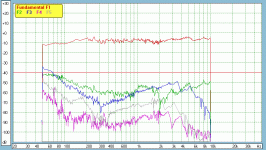 SBAcoustics-SB12MNRX25-4-HD.gif20.8 KB · Views: 760
SBAcoustics-SB12MNRX25-4-HD.gif20.8 KB · Views: 760 -
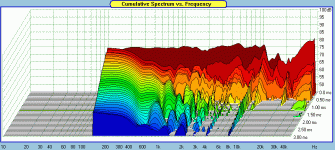 SBAcoustics-SB12MNRX25-4-CSD.gif29.1 KB · Views: 757
SBAcoustics-SB12MNRX25-4-CSD.gif29.1 KB · Views: 757 -
 SBAcoustics-SB17MFC35-8-HD.gif22.7 KB · Views: 754
SBAcoustics-SB17MFC35-8-HD.gif22.7 KB · Views: 754 -
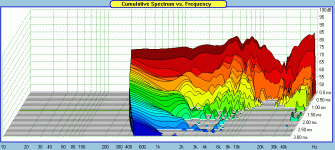 SBAcoustics-SB17MFC35-8-CSD.gif24.7 KB · Views: 757
SBAcoustics-SB17MFC35-8-CSD.gif24.7 KB · Views: 757 -
 Silverflute-W14RC25-HD.gif20.8 KB · Views: 746
Silverflute-W14RC25-HD.gif20.8 KB · Views: 746 -
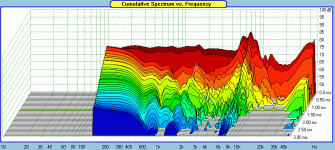 Silverflute-W14RC25-CSD.gif30 KB · Views: 128
Silverflute-W14RC25-CSD.gif30 KB · Views: 128
Bravo jReave, my oppinion too.
Here's something from Jeff Bagby: Archos Open Baffle - home
Zaph did measurements for a large number of 6.5" drivers. Among them is b&c 6md38. Look at distortion and fr measurements and watterfall too. It simply wants to be crossed from 350 to 2500 hz.
Here's something from Jeff Bagby: Archos Open Baffle - home
Zaph did measurements for a large number of 6.5" drivers. Among them is b&c 6md38. Look at distortion and fr measurements and watterfall too. It simply wants to be crossed from 350 to 2500 hz.
Then again you can add in some better performing 5" driver to the mix too.


And then two other 6" if you want.
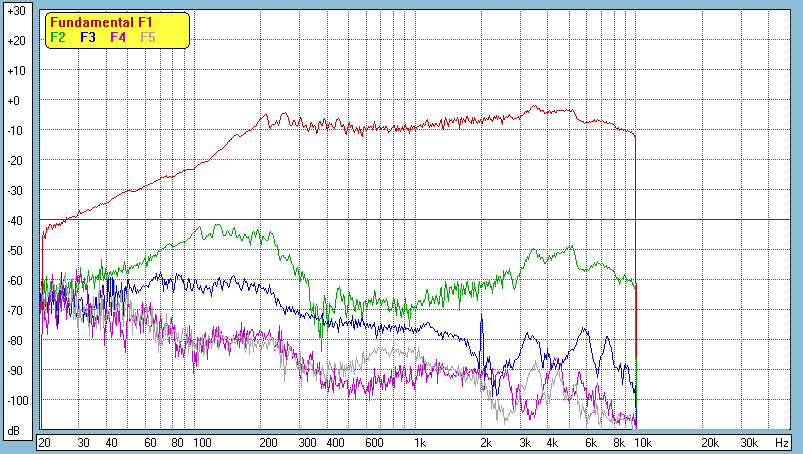
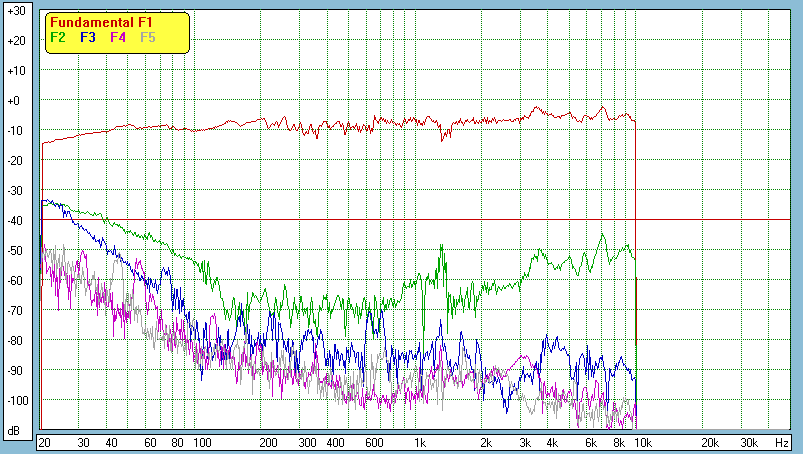
I mean it all depends on what you want the driver to do and what is available.
Usually 6" mid/bass drivers have a higher end sensitivity than their 5" counterparts and this could play a rather significant role in what driver you select for your mid.
If you placed the Satori motor into a 5" driver and optimised it for midrange performance, ie 90dB+ sensitivity, ultra low distortion, excellent cone, it'd probably be a complete no brainer vs anything we've really posted so far, but it doesn't exist. A 5" Satori is on the way, but that's going to be a mid/bass, not a dedicated mid. And people may then prefer to pick the 6" version if it has a dB or two extra sensitivity.


And then two other 6" if you want.


I mean it all depends on what you want the driver to do and what is available.
Usually 6" mid/bass drivers have a higher end sensitivity than their 5" counterparts and this could play a rather significant role in what driver you select for your mid.
If you placed the Satori motor into a 5" driver and optimised it for midrange performance, ie 90dB+ sensitivity, ultra low distortion, excellent cone, it'd probably be a complete no brainer vs anything we've really posted so far, but it doesn't exist. A 5" Satori is on the way, but that's going to be a mid/bass, not a dedicated mid. And people may then prefer to pick the 6" version if it has a dB or two extra sensitivity.
Absolutely - but you get my point. Over-generalizing about drivers, or 2-way vs 3-way speakers or whatever doesn't serve any beneficial purpose. Talk specifics instead because all kinds of variability exists within almost any given group.
Nice to know a 5" Satori is coming down the road though.
Nice to know a 5" Satori is coming down the road though.
And a 7.5" apparently.
I get your point, I think the problem is that when a 5" exists, that actually performs as well as the 6", then someone goes for the 6". Or when a loudspeaker manufacturer, like Wilson or JMLab, actually goes for 6" drivers, when they could quite easily get custom made drivers that fit the bill, that are 5". Why go for the 6"? It just makes things harder imo as the 5" will be more flexible on the top end and wont give up anything on the lower end.
I suppose the HM130Z0 from Audax comes to mind. 5", high sensitivity, will easily cross at 200Hz, cone isn't bad the only trouble is the out dated motor by today's standards. Give it an overhaul and you'd be looking at a 92dB @ 8 ohms driver, will cross at 200Hz and 2.5-3kHz, mate with pretty much any tweeter and have very low distortion. It would seem almost perfect. It doesn't exist, but it could do if someone wanted a custom driver that did.
I get your point, I think the problem is that when a 5" exists, that actually performs as well as the 6", then someone goes for the 6". Or when a loudspeaker manufacturer, like Wilson or JMLab, actually goes for 6" drivers, when they could quite easily get custom made drivers that fit the bill, that are 5". Why go for the 6"? It just makes things harder imo as the 5" will be more flexible on the top end and wont give up anything on the lower end.
I suppose the HM130Z0 from Audax comes to mind. 5", high sensitivity, will easily cross at 200Hz, cone isn't bad the only trouble is the out dated motor by today's standards. Give it an overhaul and you'd be looking at a 92dB @ 8 ohms driver, will cross at 200Hz and 2.5-3kHz, mate with pretty much any tweeter and have very low distortion. It would seem almost perfect. It doesn't exist, but it could do if someone wanted a custom driver that did.
Absolutely - but you get my point. Over-generalizing about drivers, or 2-way vs 3-way speakers or whatever doesn't serve any beneficial purpose. Talk specifics instead because all kinds of variability exists within almost any given group.
Nice to know a 5" Satori is coming down the road though.
I also agree...Absolutely!
There are all kinds of exceptions that work just fine and the notion that there is an abitrary size limitation ignores scores of successful exceptions to any "general rule".
If one needs to operate in a world of hard and fast absolutes, speaker building is going to be a very frustrating activity.
Best Regards,
TerryO
Last edited:
jReave, so you are saying that Linkwitz did not have to use 4" upper midrange in his LX521 speaker...
I disagree with many statements in your post #6, since what you say that is easily done in 2way speaker without 2nd thought is actually terrible compromise and the reason to build 3way rather than 2way speakers...
I disagree with many statements in your post #6, since what you say that is easily done in 2way speaker without 2nd thought is actually terrible compromise and the reason to build 3way rather than 2way speakers...
jReave, since you brought what looks like Zaph's measurements...do you know of any Zaph's designs which would use 6.5" as midrange in 3way? As far as I know he uses 5" max or 2" dome...
Oh please - what is he doing, crossing it over at 6kHz?? But I'll bite without knowing all the details of that specific design antways - sure, is it not possible that he could have found a 3" driver that may have also met all his design criteria?
And yes, any 2-way is a compromise (hell, all speakers for that matter are a series of compromises, although obviously, some more than others) but I certainly wouldn't call all 6.5" 2-ways "terrible compromises". Seriously, you're saying that all 6.5" 2-ways are "terrible compromises"??
And I hope you're not claiming that Zaph has some kind of monopoly on good speaker designs, because that's just absurd (although he does have some good 6.5" 2-way designs). 😉 😀
And yes, any 2-way is a compromise (hell, all speakers for that matter are a series of compromises, although obviously, some more than others) but I certainly wouldn't call all 6.5" 2-ways "terrible compromises". Seriously, you're saying that all 6.5" 2-ways are "terrible compromises"??
And I hope you're not claiming that Zaph has some kind of monopoly on good speaker designs, because that's just absurd (although he does have some good 6.5" 2-way designs). 😉 😀
In an ideal world, with typical cones and domes, then yes, you'd be better off using a 5" as your midrange than you would a 6-7", or heck a 4" if you can easily crossover higher to the bass driver.
But I think the main point here is that it isn't easy to find all the parameters you'd want in your midrange driver and this unfortunately means a gigantic compromise.
For example B&Ws 140cm^2 FST presumably needs that much SD to get down low enough with the FST surround, otherwise they'd probably have used something a bit smaller.
But there is also the issue of - been there done that - even if what you did before is a better idea. I am thinking of Troels here. He's done loads of design and has many with small midrange drivers and then many with larger ones. It'd get boring if he did the same 8-10"+5"+1" format every time, I mean that isn't what you want to hear you're interested in building one of his designs and would rather he had actually used a 5" if available, but it probably has a lot truth behind it. Making something 'different' or 'less than ideal' work well might just be the challenge that a specific designer wants. Trouble is Troels never crosses his 6-7" mid drivers low enough. Most manufactures don't either.
But I think the main point here is that it isn't easy to find all the parameters you'd want in your midrange driver and this unfortunately means a gigantic compromise.
For example B&Ws 140cm^2 FST presumably needs that much SD to get down low enough with the FST surround, otherwise they'd probably have used something a bit smaller.
But there is also the issue of - been there done that - even if what you did before is a better idea. I am thinking of Troels here. He's done loads of design and has many with small midrange drivers and then many with larger ones. It'd get boring if he did the same 8-10"+5"+1" format every time, I mean that isn't what you want to hear you're interested in building one of his designs and would rather he had actually used a 5" if available, but it probably has a lot truth behind it. Making something 'different' or 'less than ideal' work well might just be the challenge that a specific designer wants. Trouble is Troels never crosses his 6-7" mid drivers low enough. Most manufactures don't either.
Crossing the tweeter at a lower frequency so that a large mid doesn't have to go up so high, isn't really fixing that much. Sure, you might be able to avoid cone breakup, but there will almost always be a directivity mismatch since the tweeter usually fires into half-space at its HP point, whereas the mid usually has narrowing directivity at its LP.
See the Ardor for a counter-example.
http://www.diyaudio.com/forums/multi-way/193689-build-thread-ardor-point-source-monitor.html
See the Ardor for a counter-example.
http://www.diyaudio.com/forums/multi-way/193689-build-thread-ardor-point-source-monitor.html
Sure, you might be able to avoid cone breakup, but there will almost always be a directivity mismatch since the tweeter usually fires into half-space at its HP point, whereas the mid usually has narrowing directivity at its LP.
[/url]
If you cross over a 6.5" at around 1700Hz you mitigate the worst of this and only end up with a small amount of off axis dip. It isn't perfect, but it isn't that much of a problem either. Sure, using a wave-guide is the best solution, but most people seem not to like doing that.
Thank jReave for the detailed explanation.
I would like to choose chart 1&2 because the frequency reponse of upper mid at 0.0ms is quite flat. That means, it doesn't need additional passive components, such as CR or LCR filters which makes the sound terbid, to flatten the crossover range.
Your comment, "Could that 6.5" driver possibly have lower distortion and a better damped cone than a 4" or 5" one? Could it possibly sound better? Obviously, there are many designers who think the answers to those questions is yes." is quite impressive.
Is this comment about the "midrange" or "mid-bass range" of the driver ?
I would like to choose chart 1&2 because the frequency reponse of upper mid at 0.0ms is quite flat. That means, it doesn't need additional passive components, such as CR or LCR filters which makes the sound terbid, to flatten the crossover range.
Your comment, "Could that 6.5" driver possibly have lower distortion and a better damped cone than a 4" or 5" one? Could it possibly sound better? Obviously, there are many designers who think the answers to those questions is yes." is quite impressive.
Is this comment about the "midrange" or "mid-bass range" of the driver ?
- Status
- Not open for further replies.
- Home
- Loudspeakers
- Multi-Way
- Why 6.5 inches as a midrange ?